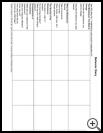
Breath-Holding Spells: Brief Version
What is a breath-holding spell?
A breath-holding spell is when your child holds his breath until he passes out. Breath-holding spells start at age 6 months to 2 years. These spells usually stop when a child is 4 or 5 years old. Breath-holding spells are not dangerous. They don't lead to any brain problems. Your child may hold his breath when he is injured, angry, or scared.
During a breath-holding spell:
- Your child may make one or two cries and then hold his breath until he becomes blue around the lips and passes out.
- Your child may stiffen out when he or she passes out.
- Your child will breath normally again and become fully alert in less than 1 minute.
People have a reflex that causes them to breathe after they have been holding their breath. This reflex doesn't work well in some children and they pass out before taking a breath.
How can I take care of my child?
- Treatment during breath-holding.
These spells are harmless and stop by themselves. During a spell, your child should lie flat. Lying down makes more blood go to the brain and may keep the muscles from jerking. Put a cold, wet washcloth on your child's forehead until he starts breathing again. Don't start mouth-to-mouth resuscitation or call a rescue squad (911). It's not necessary.
- Treatment after breath-holding.
Give your child a quick hug and go about your business. A relaxed attitude is best. If your child had a temper tantrum because he wanted his way, don't give in after the spell. If your child has a lot of attacks, ask your doctor to check your child for anemia.
Call your child's doctor during office hours if:
- More than one spell occurs each week.
- The attacks change.
- You have other concerns or questions.
CAUTION: Call a rescue squad (911) if your child stops breathing for more than 1 minute.
Last modified: 2008-08-11
Last reviewed: 2016-06-01

